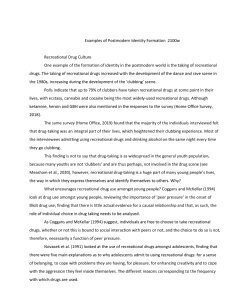Examples of Postmodern Identity Formation Recreational Drug Culture One example of the formation of identity in the postmodern world is the taking of recreational drugs. The taking of recrea2100w
Examples of Postmodern Identity Formation Recreational Drug Culture One example of the formation of identity in the postmodern world is the taking of recreational drugs. The taking of recrea2100w
Examples of Postmodern Identity Formation 2100w
Recreational Drug Culture
One example of the formation of identity in the postmodern world is the taking of recreational drugs. The taking of recreational drugs increased with the development of the dance and rave scene in the 1980s, increasing during the development of the ‘clubbing’ scene.
Polls indicate that up to 79% of clubbers have taken recreational drugs at some point in their lives, with ecstasy, cannabis and cocaine being the most widely-used recreational drugs. Although ketamine, heroin and GBH were also mentioned in the responses to the survey (Home Office Survey, 2018).
The same survey (Home Office, 2019) found that the majority of the individuals interviewed felt that drug-taking was an integral part of their lives, which heightened their clubbing experience. Most of the interviewees admitting using recreational drugs and drinking alcohol on the same night every time they go clubbing.
This finding is not to say that drug-taking is as widespread in the general youth population, because many youths are not ‘clubbers’ and are thus perhaps, not involved in the drug scene (see Measham et al., 2020), however, recreational drug-taking is a huge part of many young people’s lives, the way in which they express themselves and identify themselves to others. Why?
What encourages recreational drug use amongst young people? Coggans and McKellar (1994) look at drug use amongst young people, reviewing the importance of ‘peer pressure’ in the onset of illicit drug use; finding that there is little actual evidence for a causal relationship and that, as such, the role of individual choice in drug taking needs to be analysed.
As Coggans and McKellar (1994) suggest, individuals are free
